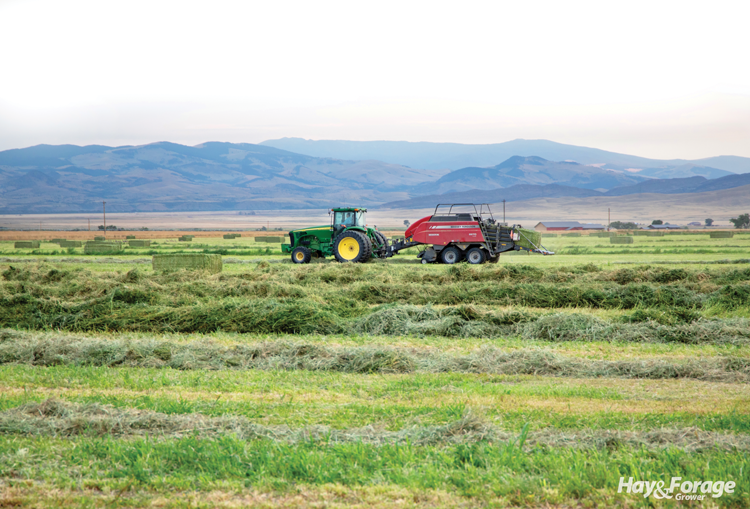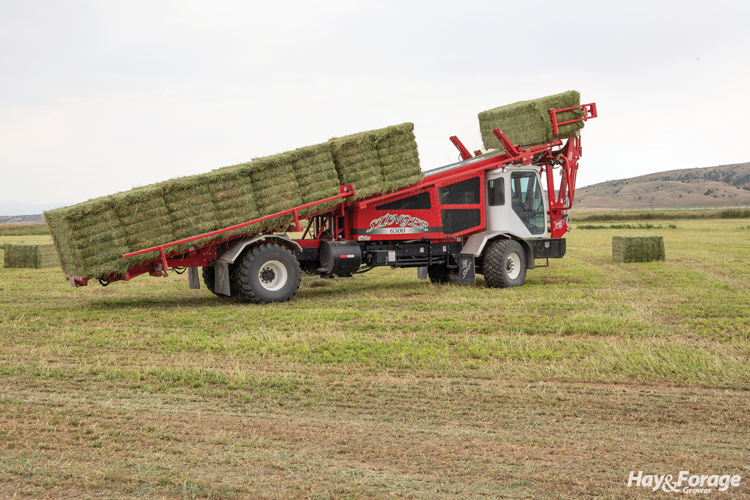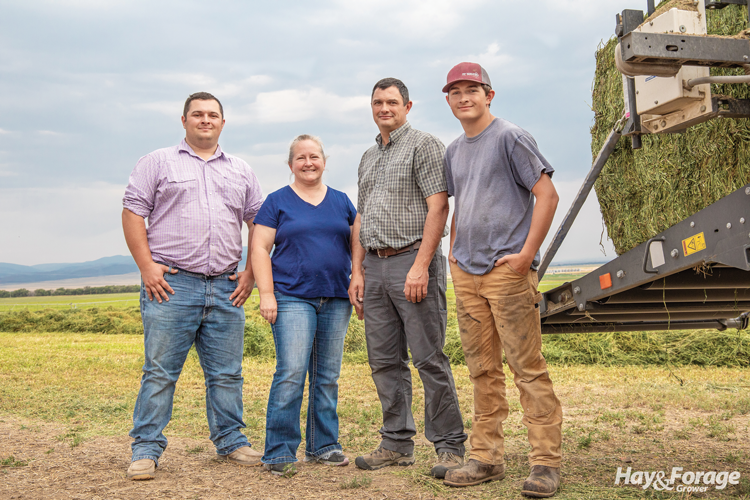From wannabe vets to successful alfalfa growers |
| By Mike Rankin, Managing Editor |
|
|
 One of Jason Noyes’s three 3x4 large square balers operates near Toston, Mont., last August. He sells most of his production to dairy farms, so forage quality is a high priority. When one door slams shut, fortune will usually open another . . . or so the old saying goes. Jason and Karen Noyes probably wouldn’t argue, although they’d also say that second door doesn’t always constitute a perfectly smooth ride. The couple met in college as animal science majors in the mid-1990s and had their sights set on becoming veterinarians. There was just one problem: Montana State University didn’t have a veterinary school. There was a program offered by the state of Montana for five students attending a college within the state to attend an out-of-state veterinary college at an in-state tuition level, but the competition was stiff with 100 applicants per year. After applying, the couple would learn that they both made the alternate list. Close, but not close enough. They decided to kill a year working on Karen’s parents’ home farm near Toston, Mont., and reapply the following year. They did, but both were again informed of the same alternate list fate. “That was the point where my wife and I decided to make farming our career,” Noyes said. In 1998, the year that the Noyeses joined the family operation, the farm only grew small grain crops. “We needed something to break the rotation,” Noyes recalled. “We tried canola for a while, pinto beans, and even chickpeas. Nothing really solved the rotation problems we were fighting with the grain-on-grain situation. My father-in-law, Leonard, had experimented with hay years earlier, but he had little interest or patience for making hay. It was evident to me, by watching the neighbors, that alfalfa was a good commodity in this valley and the five-year break in fields was exactly what our grain crops needed,” he added. Noyes planted the first 90 acres of alfalfa in 2003 and produced about 250 tons. Twenty years later, they now cut an average of 1,800 to 2,000 acres and market close to 10,000 tons of irrigated alfalfa hay and 4,000 tons of barley and wheat straw.  Bales are picked up and stacked by a custom service using Stinger units. Not without challenges The initial foray into alfalfa hay wasn’t without a steep learning curve for Jason and Karen, as their previous experience was limited. “One of the hardest struggles in the beginning was not having a direct mentor who could lend advice on how to make quality hay,” Noyes said. “I didn’t have a father or grandfather who had been putting up hay for years like a typical family operation. My father-in-law was a successful grain farmer. He disliked hay for the fact that you could never be guaranteed a time for sale and income. It was unlike a bin full of grain and knowing any day you can haul a load to an elevator and get payment for it. Hay simply doesn’t work that way.” Noyes relied on reaching out to neighbors and his wife’s uncle for advice. “I made a lot of mistakes and baled a lot of hay those first years that turned brown or worse in the stack because the moisture wasn’t correct. Trying to develop markets from scratch was also an obstacle that took time to overcome.” Fortunately, circumstances have changed for the better. These days, it’s the neighbors who call Noyes for advice. Noyes’s alfalfa acres have expanded to comprise about one-third of the farm’s nearly 6,500 acres. The operation is spread out, spanning 28 miles from one end to the other, which Noyes asserted can sometimes be a challenge and cause a lot of “road time.” The other two crops grown on the farm are wheat and malting barley. Caters to dairy markets Currently, Noyes only grows stands of pure alfalfa. “We’ve debated bringing some grass in,” he said, “but our market has predominantly been with dairy farms. We sell a lot of beef-cow hay, too, but it’s still straight alfalfa.” Noyes surmised that being in Montana is a blessing because they can ship hay in a lot of different directions. He explained that their dairy markets may vary slightly from year to year, depending on regional demand. “One year we may go west to Idaho and Washington, and the next year we may ship more hay to Wisconsin. Of course, we have some dairies in Montana that we take care of every year. About 60% of our customer base buys hay from us on an annual basis,” he added. The operation does its own trucking within state. Out of state, Noyes looks for backhauls to move hay. “In 2021 and 2022, Montana was under a severe drought and we sold virtually all of our hay within state, but those years were exceptions. We’ve never had to sit on hay; it all gets sold, even if I get less money than I would have liked toward the end of spring. We don’t have cattle, so there’s nothing we gain by holding on to it.” Noyes’s hay marketing strategy has evolved over the years. It took time to build a client base, and that meant more advertising was needed in those early years. “We currently do some advertising in papers and on social media to move hay, but not a lot,” Noyes said. “A number of years ago, I put a ‘Quality Alfalfa Hay for Sale’ sign out on the highway, and you wouldn’t believe how much hay we’ve sold from that sign alone and picked up a lot of truckers who were looking for a load. In the hay business, word of mouth sells a lot of hay, too. Of course, that can go both ways if you don’t develop a good reputation,” he added. With so many dairies as customers, all of Noyes’s hay gets tested and is stored outside under a tarp. “I’d love to have some big hay sheds, but we’re so spread out in the valley that we’d end up trucking hay all season,” he explained.  It’s all hands on deck when the 2,000 acres of alfalfa hay is ready to cut and bale. From left to right: Tyler, Karen, Jason, and Colton Noyes. Makin’ hay Alfalfa is seeded at 16 pounds per acre into a tilled seedbed during spring. Noyes sticks to nontraited varieties, choosing to limit his glyphosate applications to the farm’s grain crops and keeping his options open for the export market if the opportunity arises. Two cuttings are made the seeding year, then three cuttings each year after. Alfalfa fields remain productive for five years, including the seeding year. “I start looking for a cutting window beginning in mid-June, then we typically take our second cutting in early August and the third during mid- to late September, which often offers the best quality hay made each year,” the veteran haymaker said. Alfalfa is cut with two Massey Ferguson 9980 16-foot disc mowers, then is put into windrows with Vermeer basket-type rakes. Baling is done with three Massey Ferguson 3x4 large square balers. A custom service with Stinger units is contracted to pick up and stack bales. All of the balers are equipped with Gazeka moisture testers. Any bales that are over 18% moisture are marked at the baler. Noyes generally likes to bale at 14% moisture or less. No hay preservative is used; rather, he just prefers to be patient and wait for an acceptable baling moisture. Noyes typically budgets for a yield of 6 tons of hay per acre, although he noted that in years two through four, they often will get closer to 7 tons per acre. Each hayfield is soil tested every year and the farm has its own fertilizer storage and blending facility. Phosphorus is the nutrient that comprises the bulk of the alfalfa fertility program. “Our ground here is naturally high in potassium,” Noyes explained, “but we still have to put some on, just not a lot.” He added that they are fortunate not to have to invest much for insect control, only occasionally spraying for weevils, grasshoppers, or cutworms.  This highway sign has sold a lot of hay and attracts truckers looking for loads. Good help and future In addition to three full-time employees who help with both the hay and grain operation, a nephew who is now employed full time, and Karen’s parents, the Noyeses’ four children have all been active on the farm. The oldest, Tyler, recently graduated from Montana State University (MSU) and is a high school agriculture teacher in Montana. Their daughter, Taylor, graduated from MSU this past December with a degree in animal science and is currently employed in the embryo transfer industry in Texas. Colton, a sophomore at MSU, is majoring in plant science and plans to come back to the farm after graduating, while their youngest daughter, Kaitlyn, is a sophomore in high school. In addition to the never-ending farm work, members of the Noyes family have all dedicated themselves to numerous different community groups and volunteer roles. That includes being active and taking leadership roles in their local 4-H and FFA programs. Additionally, Jason has been on the school board for the past six years and has served as chairman for the most recent five of those. The future remains bright for haymaking activities on this Montana operation, and it all started with two people who couldn’t quite beat the 5% odds of getting into veterinary school. It’s doubtful there are too many regrets, though. In summarizing the operation’s journey, Noyes reflected, “Alfalfa was originally intended to simply enhance the grain operation, but it has recently taken over as the farm’s highest net income per acre commodity. Making hay is what I love to do.” This article appeared in the March 2024 issue of Hay & Forage Grower on pages 22-24. Not a subscriber? Click to get the print magazine. |
